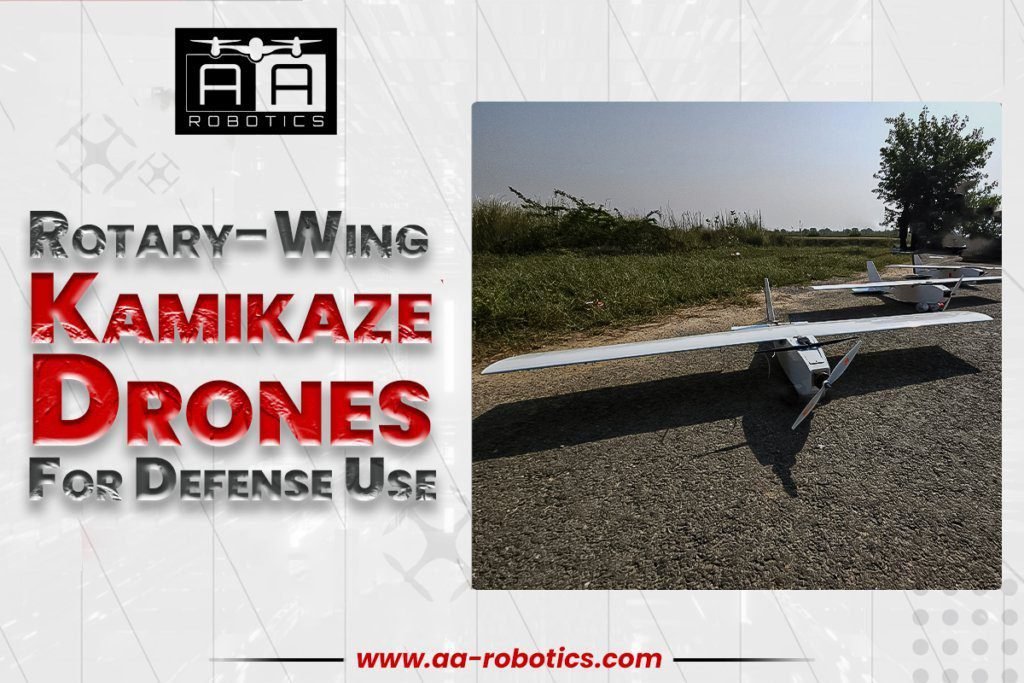
Types of Kamikaze Drones
The technologies that have revolutionized modern warfare and civilian applications over the last decade or so include unmanned aerial vehicles or drones. Among all kinds of drone variants, Kamikaze drones, also referred to as loitering munitions, are one type used for tactical purposes with lethally precise accuracy. These drones tend to hover over some target area for some time where they can detect and engage instantaneously. Increasing the complexity and operational effectiveness of kamikaze drones has made them the favourite tools in both military and defence plans worldwide. Now, in this AA Robotics article, we’ll dive into the varieties of kamikaze drones, their roles, and how they are changing the face of innovation.
Fixed-Wing Kamikaze Drones
Fixed-wing Kamikaze Drones have an aeroplane-like structure that allows them to glide for long periods in the air. These drones usually possess high-definition cameras and complex targeting systems, which thereby makes them conduct rather detailed surveillance before they engage a target. Their fixed-wing design gives longer durations of flight; they can hover for hours over a prescribed area, loitering and waiting for the ideal moment to strike. It will dive at high speed towards a target, as indicated, to detonate onboard explosives at impact.
A fixed-wing kamikaze drone has the advantage of extended coverage, which makes it ideal for deep-strike missions and areas that are difficult to access. It is mainly used by forces targeting high-value assets like command centres, missile launchers, or even just the armoured vehicle. As these drones are pre-programmed into autonomous flight, their use does not necessarily demand the presence of the operator all the time. A kamikaze drone is truly a game-changer in modern warfare. It can offer precision and lethality as if killing two birds with one stone.
Rotary-Wing Kamikaze Drones

Rotary-wing kamikaze drones can be more agile compared to their fixed-wing counterparts. They are commonly utilized in scenarios that demand increased agility and vertical takeoff. These drones will be well-suited to targets in an urban area or environment in which a restricted flight path may be involved. The ability of rotary-wing kamikaze drones to hover in place gives them a unique tactical advantage, especially where stealth and precision are required.
Another very important characteristic of rotary-wing kamikaze drones is their flexibility. It may be used in close areas, thus making it one of the tools of war more suitable for urban warfare and close-quarters engagements. Its hovering capability will enable an operator to closely monitor a target before reaching out in search of the optimal time to strike it. Those little drones are equipped with sensors and imaging technology, feeding back the surveillance information to their operators in real time, thus ensuring the accuracy and effectiveness of the strike.
Hybrid Kamikaze Drones
Hybrid kamikaze drones are actually a fusion between fixed-wing and rotary-wing designs. They may be considered the best of two worlds. They take off like helicopters but transition into fast-forward, efficient flight, just like an aeroplane. Added flexibility in operations from a hybrid design allows them to conduct everything from long-range reconnaissance missions to short-range strikes.
Hybrid kamikaze drones are versatile and, thus, in huge demand among varied military forces. They are looking at a single platform that can perform various roles. Such drones are applied where traditional fixed-wing or rotary-wing drones would be less effective. Switching from hovering to cruising mode makes them capable of targeting both open and confined spaces with precision. The hybrid design also enhances the endurance in flight and minimizes the chances of being discovered by the enemy.
Besides their attacking capabilities, hybrid kamikaze drones increasingly find applications in ISR missions. With the capability to loiter over an area for a considerable time and advanced sensors, hybrid drones can garner real-time information. Hybrid drones also install autonomous flight systems, which execute sophisticated missions with minimal human intervention.
Autonomous Kamikaze Drones
Autonomous kamikaze drones represent the state of the art in drone technology because such systems are laden with very advanced levels of artificial intelligence and machine learning technology. Therefore, these types of systems do not require continuous human control once deployed; they can operate independently to identify, trace and determine targets. This level of autonomy improves operational efficiency while reducing the risk of human error in combat missions.
Autonomous kamikaze drones are used in higher-risk and contentious environments in situations where human controllers cannot provide real-time guidance. These are programmed for pre-determined flight paths, identification, and strikes according to AI algorithms, thus hitting moving or even covered targets with a high level of accuracy.
One great advantage of the autonomous kamikaze drones is that they can be used in swarms. Swarm technology enables coordination of the movement and attacks of a multitude of drones, which means beating down enemy defenses through really high levels of attack intensity. The tactic has been proved to be extremely potent in the contemporary conflict by utilizing swarms of autonomous kamikaze drones to disable enemy air defenses, radar systems, and other important infrastructure.
Conclusion
Kamikaze drones invading the battlefield of today have altered the nature of modern warfare. It means that military forces have an extremely versatile and potent tool meant strictly for precision strikes-from large, fixed-wing drones designed to carry out longer-range missions to rotary-wing drones perfect for fighting in urban centers. Fully autonomous and hybrid drones in general increase the sophistication and flexibility of systems that could continue on complex missions with minimal human oversight as they function independently.
AA Robotics has come as one of the companies leading the kamikaze drone industry. It is opening up to modern military needs through innovative designs on kamikaze-type drones integrating AI, hybrid technology, and ruggedness. Amid growing interest in kamikaze drones by the public and private sectors, AA Robotics is in a very strategic position to play a major role in shaping the future of unmanned warfare.
Kamikaze drones are applied in precision strikes against enemy targets. They loiter over a target area, identify high-value assets, and engage in one-time strike ability in the process.
They are equipped with AI and ML systems so that they can freely engage in searching, tracking, and attacking targets.
Fixed wing is designed for long-range missions that glide over large areas, but rotary wing is more agile and ideal for confined spaces or in an urban environment.
There are companies like AA Robotics, which focus more on innovation, durability, and integrating AI into the products they make. Their drones end up being durable, allowing them to withstand hostile conditions, operate autonomously, and adapt to various missions; hence, they are considered among the most trusted manufacturers in the industry.


